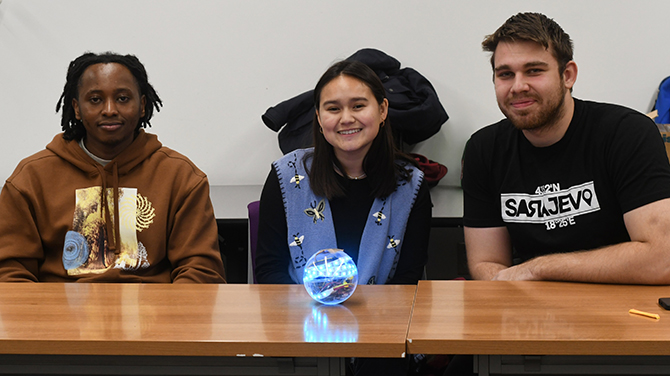Microprocessor System Design Students Demo Final Projects
Students expressed creativity and ingenuity in the design of practical, microcontroller-based embedded systems for their final course projects
Integrating processors, sensors, and data exchange functionality into everyday objects, the Internet of Things (IoT) pushes computing capabilities far beyond desktops and servers.
 On December 5, students in the COMP_ENG 346: Microprocessor System Design course led by Northwestern Engineering’s Branden Ghena presented a hands-on, public demonstration of their microcontroller-based embedded systems.
On December 5, students in the COMP_ENG 346: Microprocessor System Design course led by Northwestern Engineering’s Branden Ghena presented a hands-on, public demonstration of their microcontroller-based embedded systems.
For the course’s final project, teams designed, built, and programmed open-ended hardware/software systems using microcontrollers that feature a processor, memory, and peripherals within a single chip. Students embedded the microcontrollers into circuit boards alongside sensors, batteries, and interfaces to create IoT inventions.
The course draws students earning undergraduate and master’s degrees pursuing careers in fields including computer science, computer engineering, mechanical engineering, and robotics.
“I'm consistently impressed by the ingenuity and creativity that students apply to their projects,” said Ghena, an assistant professor of instruction at the McCormick School of Engineering. “They take the engineering knowledge they learn in classes and go way beyond that.”

To meet the project’s technical parameters, students were required to incorporate at least two sensors and one output. Beyond that, the 23 teams of students were free to express their creativity and ingenuity through a variety of system designs, including smart objects, wearables, interactive games, control interfaces, and monitoring systems.

Teams and projects demonstrated during the event were:
- Active Security Door: Eli Barlow, Gabe Bider
- Air Hockey: Arya Bulusu, Lauren Xie
- Alarm Clock: Jesus Montero, Alvaro Reynoso
- Ankle Biter 3000: Graham Clifford, Rahul Roy
- Card Dealer: Shail Dalal, Kyle Wang
- Chess Board: Kellen Bryant, Robert Yang
- Chibi-Totoro: Lawrence Chang, Charles Cheng, Tommy Li
- Eating Detection: Jiahong Zheng, Jiayi Zheng
- Glove-controlled Robot: Angela Davis, Chris Song
- GoLite Reaction Game: James Kim, Han Lee, Jiayan Luo
- Home Emergency System: Hongyi Cai, Ruiqi Cai, Winnie She
- Home Security System: Adrian Hoffer, YueXi Mo, Dev Sanghi
- Meow-crobit: Alex Huggins, Kelly Mei, Andres Rojas, Lester Tai
- Motion Mouse: Dilan Nair, Sahana Vandayar, Naomi Wu
- Music Player: Deniz Gorur, Youssef Ibrahim, Jim Wei
- Operation Game: Edward Chen, Emily Zhang
- Party Ball: Haris Bajramovic, Erick Mungai, Chele Shuart
- Plant Pal: MJ Nidea, Ebube Okonji, Blaise Webbeking
- Robot Pet: Nadharm Dhiantravan, Thomas Filipiuk, Graham Grieb
- Smartwatch: Avinash Bedi, Sneh Deshpande, Lucas Takayasu
- Snap-on/off Light: Angeli Mittal, Aryaan Singh
- Tree Monitor: Maya Garcia, Shray Vaidya
- Wall-E: Isa Gonzalez, Audrey Benitez Rojo, Hannia Santillan Valera

Through lectures, practical lab sessions, and the final project, Microprocessor System Design students explore topics including microcontrollers, embedded software, digital and analog input and output, timers, wired communication protocols, and basic wireless communication. Students experiment primarily with the Micro:bit v2 platform using the C programming language.




